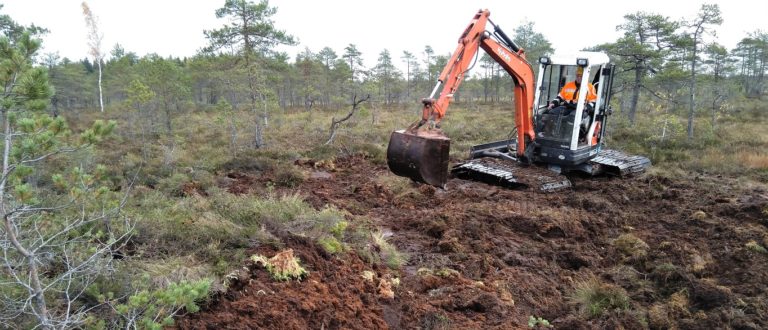In order to acquaint the interested parties with the peatland restoration technique used by LIFE Peat Restore in the project areas in Latvia, the project team organized a demonstration seminar on 9 October 2020. The seminar took place in Madiešēni Mire in Augstroze Nature Reserve (Latvia) and gathered 25 participants, mainly peatland experts and practitioners.
During the seminar, the participants were introduced to the entire work process including the final stage, construction work. The full cycle includes planning and designing works – field inventories and modelling, development of nature protection plan, development of technical designs, coordination of technical designs with the national and municipal authorities. The participants were also introduced to the objectives of the LIFE Peat Restore project and the actions already implemented, the methods used in monitoring of vegetation and water table, the GEST method, and instrumental measurement of greenhouse gases. The field seminar was held in a place where long-term observations take place, thus it was possible to see a greenhouse gas measurement station set up during the project.

The demonstration of the peat dam construction aroused the greatest interest. This type of demonstration, available to a wider audience, not only the directly involved staff, took place for the first time in Latvia. In the construction of dams in all project territories, including Madiešēni Mire, light small-sized technical units with low pressure on the ground are being used, therefore no permanent damage is caused to the peatland. The project team and technical operators have a vast experience in peat dam construction gained in previous projects.
Most of the seminar participants acknowledged that they have seen such dams in other peatland areas, but this was an opportunity to observe not only the result, but also the work process. After the demonstration, it was possible also to visit several peat dams built in the previous day.
The locations, techniques and potential impact of the dams were planned by experts from the University of Latvia, whereas the design and construction works were performed by the project partner E Būvvadība. The dam construction in Augstroze Nature Reserve continues and will be completed in the coming days. During the seminar, also the film-making crew (project partner, Rucka Art Foundation) participated by taking shoots for the documentaries planned within the project.
Similar peat dams are already built in another project area in Latvia, Baltezers Mire Nature Reserve, where the work was completed in the end of August 2020.
Here, we provide an insight into the process of peat dam construction.






